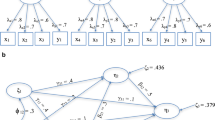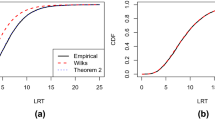Abstract
PINDIS, as recently presented by Lingoes and Borg [1978] not only marks the latest development within the scope of individual differences scaling, but, may be of benefit in some closely related topics, such as target analysis. Decisions on whether the various models available from PINDIS fit fallible data are relatively arbitrary, however, since a statistical theory of the fit measures is lacking. Using Monte Carlo simulation, expected fit measures as well as some related statistics were therefore obtained by scaling sets of 4(4)24 random configurations of 5(5)30 objects in 2, 3, and 4 dimensions (individual differences case) and by fitting one random configuration to a fixed random target for 5(5)30 objects in 2, 3, and 4 dimensions (target analysis case). Applications are presented.
Similar content being viewed by others
Reference note
Langeheine, R. Approximate norms and significance tests for the Lingoes-Borg procrustean individual differences scaling (PINDIS). Research Report No. 39. Kiel, Institute for Science Education, 1980.
References
Andrews, F. M. & Inglehart, R. F. The structure of subjective well-being in nine western societies.Social Indicators Research, 1979,6, 75–90.
Borg, I. Geometric representations of individual differences. In J. C. Lingoes, E. E. Roskam, & I. Borg (Eds.),Geometric representations of relational data. Readings in multidimensional scaling. Ann Arbor: Mathesis Press, 1979.
Borg, I.Anwendungsorientierte Multidimensionale Skalierung. Berlin: Springer, 1981.
Borg, I. & Bergermaier, R. Die Ähnlichkeit von Einstellungsstrukturen zur Lebensqualität in elf westlichen Gesellschaften.Zeitschrift für Sozialpsychologie, 1979,10, 253–261.
Borg, I. & Bergermaier, R. Some comments on “The structure of subjective well-being in nine western societies” by Andrews & Inglehart.Social Indicators Research, 1981,9, 265–278.
Borg, I. & Lingoes, J. C. Ein direkter Transformationsansatz der multidimensionalen Analyse dreimodaler Datenmatrizen: Theorie und Anwendungen.Zeitschrift für Sozialpsychologie, 1977,8, 98–114.
Borg, I. & Lingoes, J. C. What weights should weights have in individual difference scaling?Quality and Quantity, 1978,12, 223–237.
Carroll, J. D. & Chang, J. J. Analysis of individual differences in multidimensional scaling via anN-way generalization of “Eckart-Young” decomposition.Psychometrika, 1970,35, 283–319.
Cliff, N. Orthogonal rotation to congruence.Psychometrika, 1966,31, 33–42.
Cohen, H. S. & Jones, L. E. The effects of random error and subsampling of dimensions on recovery of configurations by non-metric multidimensional scaling.Psychometrika, 1974,39, 69–90.
Coxon, A. P. M. & Jones, C. Multidimensional scaling: Exploration to confirmation.Quality and Quantity, 1980,14, 31–73.
Feger, H. Quantitative sociometry: Problems, methods and first results. In H. J. Hummell & R. Ziegler (Eds.),Anwendung mathematischer Verfahren zur Analyse sozialer Netzwerke. Duisburg: Verlag der Sozialwissenschaftlichen Kooperative, 1977.
Feger, H. Einstellungsstruktur und Einstellungsänderung: Ergebnisse, Probleme und ein Komponentenmodell der Einstellungsobjekte.Zeitschrift für Sozialpsychologie, 1979,10, 331–349.
Fischer, G. & Roppert, J. Ein Verfahren der Transformationsanalyse faktorenanlytischer Ergebnisse. In J. Roppert & G. Fischer (Eds.),Lineare Strukturen in Mathematik und Statistik. Wien: Physika-Verlag, 1965.
Graef, J. & Spence, I. Using distance information in the design of large multidimensional scaling experiments.Psychological Bulletin, 1979,86, 60–66.
Green, B. F. The orthogonal approximation of an oblique structure in factor analysis.Psychometrika, 1952,17, 429–440.
Korth, B. & Tucker, L. R. The distribution of chance congruence coefficients from simulated data.Psychometrika, 1975,40, 361–372.
Kristof, W. Die beste orthogonale Transformation zur gegenseitigen Überführung zweier Faktormatrizen.Diagnostica, 1964,10, 87–90.
Langeheine, R. The evaluation of classroom social structure by three-way multidimensional scaling of sociometric data.Studies in Educational Evaluation, 1978a,4, 185–208.
Langeheine, R. Strukturelle Stabilität—Ein neuer Ansatz zur Überprüfung der Reliabilität in der Soziometrie.Psychologische Beiträge, 1978b,20, 571–588.
Langeheine, R.Strukturanalytische Untersuchungen der Schulklasse. Eine Analyse mit Hilfe multidimensionaler Skalierungsmodelle. Frankfurt: Lang, 1979.
Langeheine, R. Structural aspects reconsidered: A reanalysis of two studies in educational evaluation.Studies in Educational Evaluation, 1980,6, 329–341.
Langeheine, R. & Andresen, N. Strukturelle Stabilität des AFS.Zeitschrift für Empirische Pädagogik, 1980,4, 203–212.
Levine, M. S.Canonical analysis and factor comparison. Beverly Hills: Sage, 1977.
Lingoes, J. C. & Borg, I. A direct approach to individual differences scaling using increasingly complex transformations.Psychometrika, 1978,43, 491–519.
MacCallum, R. C. & Cornelius III, E. T. A Monte Carlo investigation of recovery of structure by ALSCAL.Psychometrika, 1977,42, 401–428.
Maimon, Z., Venezia, I. & Lingoes, J. C. How similar are different results?Quality and Quantity, 1980,14, 727–742.
Mulaik, S. A.The foundations of factor analysis. New York: McGraw-Hill, 1972.
Nesselroade, J. R. & Baltes, P. B. On a dilemma of comparative factor analysis: A study of factor matching based on random data.Educational and Psychological Measurement, 1970,30, 935–948.
Poor, D. D. S. & Wherry, R. J. Invariance of multidimensional configurations.British Journal of Mathematical and Statistical Psychology, 1976,29, 114–125.
Roskam, E. E. Contributions of multidimensional scaling to social science research. In I. Borg (Ed.),Multidimensional data representations: When and why. Ann Arbor: Mathesis Press, 1981.
Schönemann, P. H. A generalized solution to the orthogonal procrustes problem.Psychometrika, 1966,31, 1–10.
Schönemann, P. H. & Carroll, R. M. Fitting one matrix to another under choice of a central dilation and a rigid motion.Psychometrika, 1970,35, 245–255.
Schönemann, P. H., James, W. L. & Carter, F. S. COSPA: Common space analysis—A program for fitting and testing Horan's subjective metric model.Journal of Marketing Research, 1978,15, 268–272.
Schönemann, P. H., James, W. L. & Carter, F. S. Statistical inference in multidimensional scaling: A method for fitting and testing Horan's model. In J. C. Lingoes, E. E. Roskam & I. Borg (Eds.),Geometric representations of relational data. Readings in multidimensional scaling. Ann Arbor: Mathesis Press, 1979.
Spence, I. A Monte Carlo evaluation of three nonmetric multidimensional scaling algorithms.Psychometrika, 1972,37, 461–486.
Tagiuri, R. Relational analysis: An extension of sociometric method with emphasis upon social perception.Sociometry, 1952,15, 91–104.
Tagiuri, R. Social preference and its perception. In R. Tagiuri & L. Petrullo (Eds.),Person perception and interpersonal behavior. Stanford: Stanford University Press, 1958.
Tagiuri, R. Perceptual sociometry. In J. L. Moreno (Ed.),The sociometry reader. New York: The Free Press, 1960.
Takane, Y., Young, F. W. & De Leeuw, J. Nonmetric individual differences multidimensional scaling: An alternating least squares method with optimal scaling features.Psychometrika, 1977,42, 7–67.
Weeks, D. G. & Bentler, P. M. A comparison of linear and monotone multidimensional scaling models.Psychological Bulletin, 1979,86, 349–354.
Author information
Authors and Affiliations
Rights and permissions
About this article
Cite this article
Langeheine, R. Statistical evaluation of measures of fit in the Lingoes-Borg procrustean individual differences scaling. Psychometrika 47, 427–442 (1982). https://doi.org/10.1007/BF02293707
Received:
Revised:
Issue Date:
DOI: https://doi.org/10.1007/BF02293707




